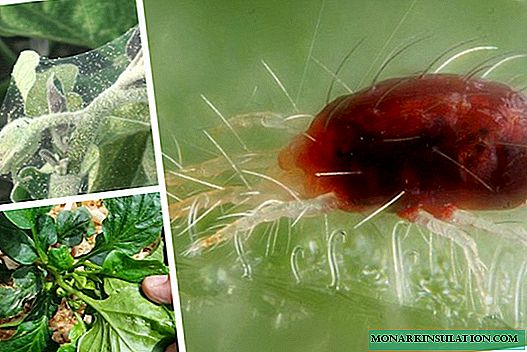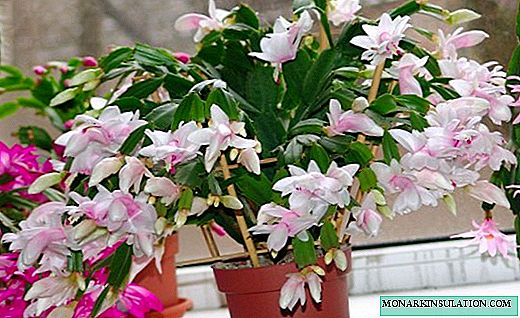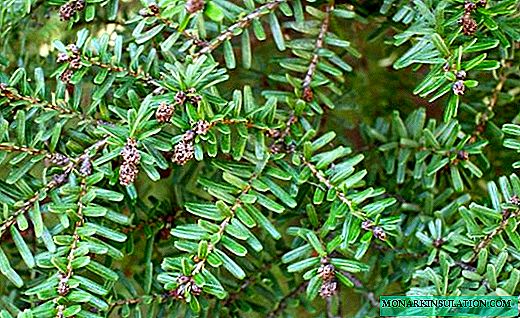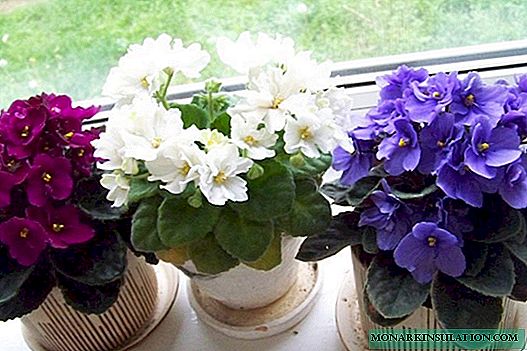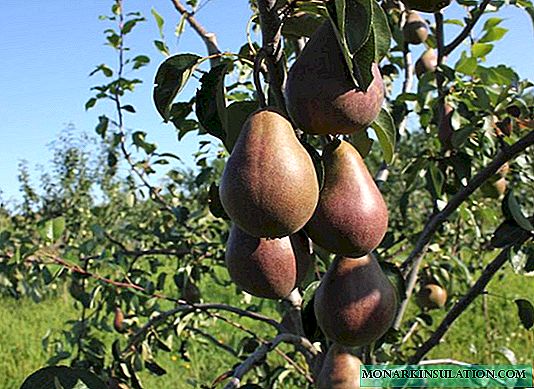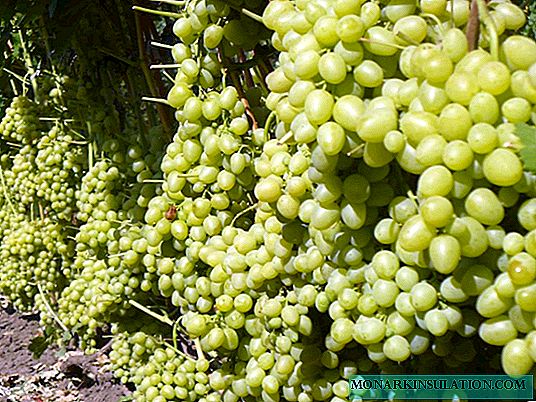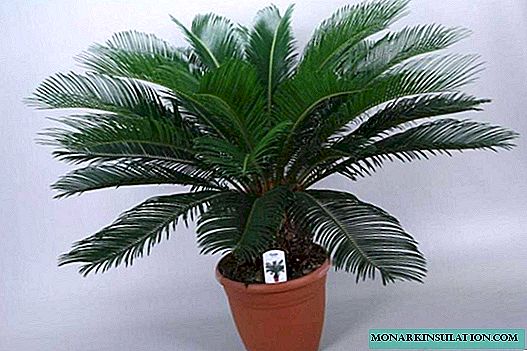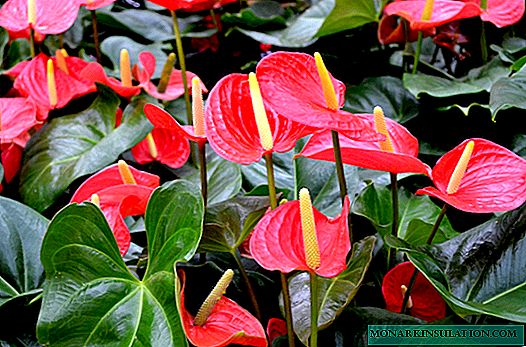The name of grassy shrubs - phlox is translated from Greek as "flame". They are popular with flower growers, not only for their bright flowering, but also because they are hardy, unpretentious. The main problem when growing phlox can be the need to protect plants from diseases and pests.
Fungal infections - the main varieties and treatment
Gardeners do not always immediately pay attention to phlox diseases. Beautifully flowering lush plants may not lose their decorativeness, but at the same time spores of fungal infections and pest larvae will already be on their leaves.
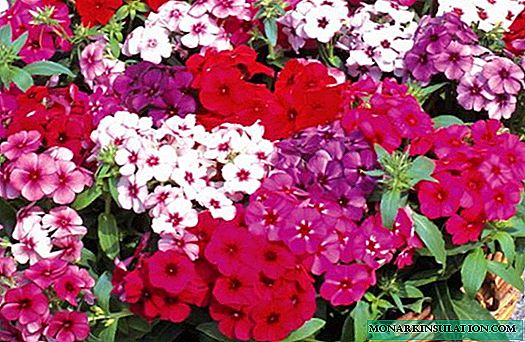
Phlox
The causes of phlox diseases can be:
- poor plant care;
- adverse climatic conditions;
- long term growing in one place;
- non-compliance with the rules of agricultural technology.
Fungal infections often appear on phlox with pollinating insects that carry pathogens on their bodies. Spores of fungi on flowers can be brought in by the wind, which spreads microorganisms not only between nearby plants, but also over long distances.
Phlox can hurt and die at any stage of its development. It is very difficult to cure them. But gardeners never refuse to fight so that plants can bloom and please their owners.
Verticillus wilting
The disease is triggered by microsclerotia of Verticillium fungi that live on plant debris in the soil up to 15 years.
The disease flares up with foci. The main symptoms of the disease are loss of turgor, that is, fullness of leaves with moisture, their yellowing, darkening and drying out, and discoloration of the stems. The fungus enters the plants through the root system, then moves to the stems, petioles, leaves, sometimes it reaches the fruits and seeds.

Verticillus wilting
You can see the mycelium of the fungus on the sections of the stems in the form of a weak grayish plaque. The mycelium clogs the conducting vessels and prevents nutrients and moisture from penetrating into the vegetative and generative organs of phlox. Most often, verticillous wilting plants begin to hurt at the stage of preparation for laying inflorescences.
It is possible to prevent the occurrence of the disease by preventive measures - removal of plant debris, autumn-spring digging of the earth, tillage with biological products and fungicides.
Plants can be treated with drugs:
- Trichodermin,
- Glyocladin
- Fundazole
- "Maksim",
- "Vitaros".
Stalk cracking
Sometimes phlox diseases and their treatment are caused by an imbalance between the amount of moisture that is necessary for plant life support and the capabilities of the root system, which cannot absorb and raise the required volume of water.

Phlox Stem Cracking
As a result, drying of the leaves and cracking of the lower zone of the stems occurs. The tissues of the stems are exposed, harden. With a sufficient reserve of nutrients and moisture in the soil, the plant suffers from their lack. Most often, this happens during the period of active vegetation - increased growth of green mass by flowers.
Having figured out why phloxes dry from below and stems crack, it is only necessary to organize top dressing of plant roots to increase their strength. Watering the root zone of phloxes helps develop root systems with solutions of root-forming drugs such as Kornevin, Epin, Amber Acid, and complex mineral fertilizers.
Additional Information: more than 50 perennial cultivated phlox species are cultivated in the world and only one annual species is Phlox Drummond.

Drummond Phlox
Leaf leaf spot
Viral diseases that affect phlox are not specific to these colors only.
Phlox leaves cause leaf leaf spotiness in viruses, and they are carried from plant to plant by pests - Longidorus nematodes. The disease manifests itself in the spring and causes the cessation of growth of the bush, deformation of the leaves. Yellow sections with characteristic ring patterns form on the leaf plates.

Phlox ring spotting
Important! Plants with ring blotch are not subject to treatment.
Having found the reason why phlox leaves are curled, the entire diseased bush is removed from the site and burned. From the land on which phlox grew, remove the surface layer of soil to the depth of the roots, the hole is treated with preparations containing chlorine (household "White") or formalin.
Leaf necrotic spotting
Before treating phloxes for diseases that cause necrotic spotting on leaves, it is necessary to understand why brown spots appear on phloxes.
The disease is caused by the cucumber mosaic virus (VOM), due to which vegetable growers lose up to 100% of the crop of tomatoes, cucumbers, peppers.
The fight against PTO is everywhere, because it is widespread wherever vegetables are grown. The virus exists on the remains of wild weeds, is transferred by insects to cultivated plants, then returns to the soil with plant debris.
VOM is destroyed along with a diseased plant. Only the elimination of diseased plants from the garden will prevent the spread of the disease to healthy flowers. The soil and garden tools are disinfected.

Necrotic spotting
Drying and falling leaves
The main factors affecting the state of phlox leaves are very dense plantings, irregular watering and top dressing, and high soil acidity.
The bushes drop leaves that the root system is not able to provide with the substances necessary for their life. After establishing a normal level of soil moisture and acidity, applying complex fertilizers, thinning the bushes, the growth of green mass resumes.
In order for the plants to stop dying, it is necessary to stop their withering. You will need to spray the leaves of phlox with a solution of Bordeaux fluid at the rate of 1 tsp. dry mixture in 7 liters of water. Basal dressing is carried out with a phosphorus-potassium mixture (in 10 liters of water, 1 tbsp of each fertilizer is diluted). Dry ash is scattered on the soil under the bushes of plants, which, when irrigated, gradually penetrates the soil and gives the microelements in the roots to the roots.
Important!To bloom phlox was magnificent, no more than 5-6 stems are left on the bushes.
Phomosis (Latin Phoma betae)
The appearance of numerous brown loose fomose spots at the base of the stems and on the root neck indicates why the leaves of phlox are curled. What to do in case of strong development of phomosis of phlox is indicated in the description of the HOM and Abiga-Peak preparations. These contact fungicides are designed to kill Phomaphlogis fungal organisms that cause phomosis.

Phomosis Phlox
Resistance to disease is shown by those plants that do not lack phosphorus and potassium. Excessive application of nitrogen fertilizers leads to weakened immunity and insecurity of flowers from the disease. Increases the resistance to fomosis pre-seed dressing of seedlings and cuttings of phlox in the solution "Fitosporina-M".
Slobbering pennies
Phlox suffer not only from pathogens, but from insects parasitizing on its bushes.
Cicadas of various colors, which are called slobbery pennies, cause significant damage to phlox bushes. Pennitsa secretes a viscous fluid in which its larvae develop. The pest lives off the tissues and juice of the plant.
Lack of nutrition leads to the fact that phlox leaves shrink, twist, buds stop growing, shoots dry out. An effective way to combat pest is to treat flower bushes with Inta-Vir, Aktara, and Tsvetofos.

Pest slobbering pennies
Leaf rust (lat.Cronartium ribicola)
About the disease, in which numerous and constantly increasing in size orange-brown spots appear on the leaves, they say that it is rust. The disease is extremely serious. In fact, at the moment, if there is rust on the phlox, how to treat it is not known. There are no chemical drugs or alternative methods of treatment.
Therefore, bad, diseased leaves break off and destroy. With the spread of rust throughout the bush, it is uprooted and burned.
If the fight against the disease begins with the onset of the very first symptoms, then using 1% iron sulfate, the preparations "Oksikhom", "Skor" it can be stopped.
Powdery mildew (lat.Erysiphaceae)
The disease, which is provoked by a fungus from the Erysiphian family, is called true powdery mildew.
The harmful fungus settles on weakened plants suffering from a lack of moisture, and is active with the onset of temperature and humidity changes.
The causative agents of the disease live in the ground, so the lower leaves of phlox are the first to suffer from powdery mildew - spots of white plaque, similar to a thick web, appear on their inside. Then the developing mycelium is stained brown. Dark spots increase, from leaves move to stems and buds.
Note!Leaves and stems of phlox infected with powdery mildew must be cut and burned. Disinfect work tools, gloves and hands.
Plant treatment is carried out by means of a high exposure rate:
- Soon
- Topaz,
- Ridomil Gold
- "Home".
Plant treatments are carried out not only during an outbreak, but also for prevention.
Nematodes (lat.Pyllotreta cruciferae)
Measures to control nematodes on phlox involve the removal of affected bushes along with a lump of earth.
Larvae of nematodes live in the soil and penetrate into the roots of phlox. At the site of penetration, loose swellings, called galls, are formed. Adult worms infect stems by feeding on their tissues.

Nematodes
The bushes inhabited by nematodes, at first cease their development, then their yellowing, drying out and death of the flowers occurs. Through tissue damage, all sorts of pathogens are carried into the plants, carried by wind and water.
Septoria or leaf spot (Latin Septoria phlogis Sac)
During the period of growing green mass, gray spots may appear on the phloxes, indicating that the plant is infected with septoria spores.
The disease has a second name - white leaf spot. It is familiar to many gardeners and gardeners, because many perennial crops are susceptible to the disease during periods of high humidity and high air temperature. During the development of the disease, gray spots turn yellow, a reddish border appears around them.
For treatment, use the tools that process the leaves and stems. The active substances of the preparations work not only on the surface of plants, but also penetrate into the stems. Protection also extends to new shoots that appear after treatment with agents such as Oxychom, Acidan.

Septoria phlox
Drooling pennies (lat.Philaenus spumarius Larve)
Pests live in gardens on cultivated plants, in meadows, in forests, parks.
If the pest colony is not numerous, then it can be controlled manually, breaking off leaves and stems with signs of pennies nesting - the formation of a sticky substance from the foamy substance inside which the insect larvae live.
But it’s hard to keep track of adult insects; they can jump from the bush and hide. Therefore, numerous insect colonies are destroyed by chemical insecticides. Folk remedies, such as decoctions of the stems and flowers of tansy, wormwood, garlic, can scare away an adult insect, but it will not be possible to destroy its larvae.
Phlox: pest protection and disease prevention
Prevention of phlox diseases and their protection from pests will be successful if, before planting phlox seedlings at a permanent place of cultivation, work is carried out to disinfect plants and soil from pathogens of insects and larvae of insects.
Important! You can not grow phlox in the same place for more than 3-4 years.
Adequate watering and timely top dressing will increase the resistance of plants to diseases and pests.
In autumn, it is necessary to dig up the soil to a depth of 30-40 cm. Fallen leaves and plant debris must be removed from the garden, preventing pathogens from wintering in them. Near the phlox, you can plant plants that with their pungent odor will repel pests.
Plants must be periodically treated with chemicals intended for disease prevention - fungicides "Maxim", "Vitaros", "Topaz", "Skor".
Alternaria Leaf
The causative agent of the disease are fungi from the genus Alternaria (Alternaria tenuis).
First of all, they populate the leaves of phlox, forming brown rounded spots on them. After some time, the number of spots increases, they merge into a single spot, the leaf plates dry out, the leaves fall off, the phlox stems are completely exposed. To prevent the disease in spring, flowers are treated with systemic fungicides, in particular, Fundazole can be used for this purpose.

Alternaria Leaf
Variegation
This disease is incurable, it occurs due to the influence of the mosaic virus of the rhesus on the formation of coloring pigments in the petals.
The virus eliminates varietal signs of flowers. Variety is transmitted by insects with juice and pollen. It also spreads with phlox seeds. Virus infection can be determined by comparison with reference plants.

Phlox's overwhelming
Jaundice
When the fact of underdevelopment of phlox bushes, curliness and chlorosis of leaves appears, experienced gardeners diagnose: microorganisms from the class of bacteria, mycoplasma, have settled on phlox.
Experiences that phlox leaves completely turn yellow, than to treat ailments, why phlox does not bloom, are justified.
Attention! Mycoplasmosis is practically not treated. Plants are destroyed, the ground under them is disinfected.
But there is a solution to the problem of how to treat phlox chlorosis, if it arose due to improper care of the flowers. The yellow tip of a young leaf on the phlox stem indicates that it lacks iron. With an increase in the number of such leaves, plants are fed with complex fertilizers, because it is difficult to determine which minerals plants need without laboratory tests.

Phlox Jaundice
Leaf threading
Signs of changes in the external structure of the leaves, the transformation of their leaf plates into threadlike formations with wavy edges indicate that the plant was attacked by the cucumber mosaic virus or populated by nematodes.
In the latter case, the change of leaves mainly occurs in the center and at the top of the stem. Plants infected with the virus do not bloom, do not increase in growth, and die quickly.
Petals
The disease is characterized by the appearance of white streaks on the leaves and flower petals. Affects the timing of flowering and the shape of the leaves of phlox.
Diagnosis of the disease is difficult, determine it by external indicators of the pattern and color of the petals. On diseased plants, the patterns are uneven. The disease is inherited and worsens varietal indicators of flowers.
Rattle
Disease indicators are rings and half rings, stripes, semicircular spots that appear on the leaves against the background of a change in their color from green to light yellow. The number of spots increases, plant growth is suspended. The cause of the disease is the pathogen Tobacco rattle virus.
Slug
Mollusks, which include land slugs, like to eat young leaves and shoots, phlox buds. In addition, they are carriers of infectious agents.
It is impossible to see slugs during the day, they are hiding in the ground, under stones, and other shelters. If you put traps in the garden in the form of pieces of cardboard, slate, you can manually collect these pests.
Attention! For the destruction of slugs, granular insecticides ("Anti-Slime") are used, which are laid on the surface of the soil.
Cruciferous black flea
Pests of the leaf beetle family - cruciferous black fleas - live in the surface soil layer, parasitize on the branches and leaves of cruciferous plants.

Cruciferous flea
From early spring, they eat shoots and phlox leaves, in the summer buds and flower petals are added to their diet. From numerous injuries, the phlox bush can die.
To destroy the pest, the soil and bushes are dusted with a mixture of tobacco dust and wood ash, dry slaked lime.
Caterpillars
Representatives of the Noctuidae family - various species of scoop butterflies - lay eggs on the stems of plants.

Butterfly scoop
Caterpillars emerging from eggs consume buds, flowers, and phlox stems. For the destruction of pests using drugs "Karate", "Fastak", carry out manual collection of insects.
Preventive treatment of planting material
Cuttings, seedlings, phlox seeds are treated with drugs that prevent the formation of rot, destroying various types of pathogens.
These include biologics:
- Actofit
- Lepidocide
- "Fitodoctor",
- "Fitoverm".
Disease prevention
So that the plants do not hurt, they need to provide good care. The soil in the areas where the flowers grow is regularly weeded, freed from plant debris, mulched if necessary to maintain sufficient moisture in the root zone of plants, fertilized, and measures are taken to protect against pests that transmit infections.

Multi-colored phlox
Ill bushes destroy and disinfect the soil. In order to prevent the spread of pathogens, conduct regular inspections of plants, remove leaves and stems with the slightest signs of disease.
Although phloxes are rather unpretentious plants, but if you do not devote time and money to caring for them, it is unlikely that you can achieve such flowers blooming in the garden that everyone would admire without exception.

